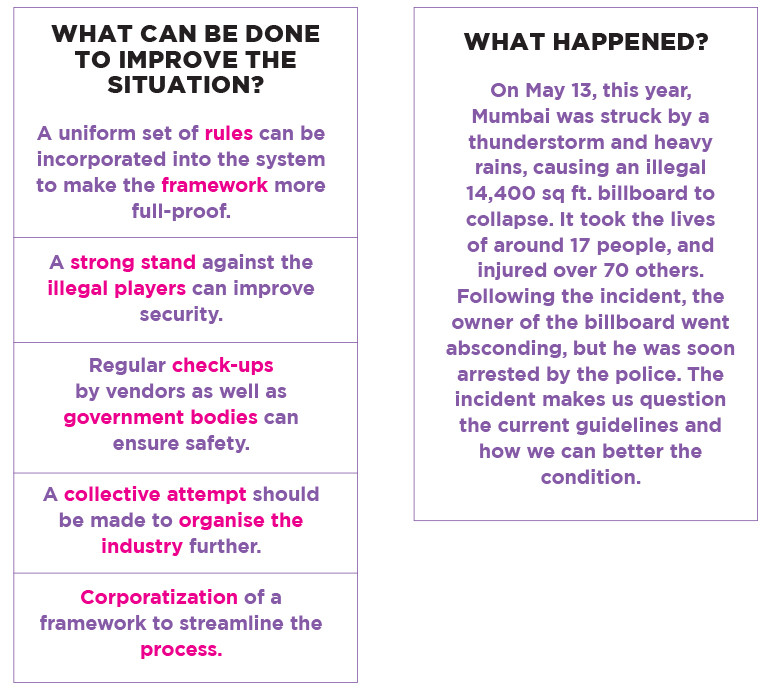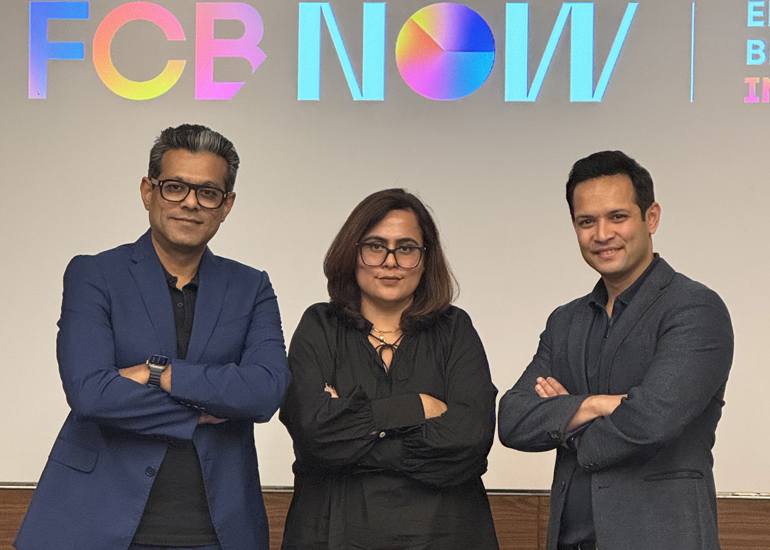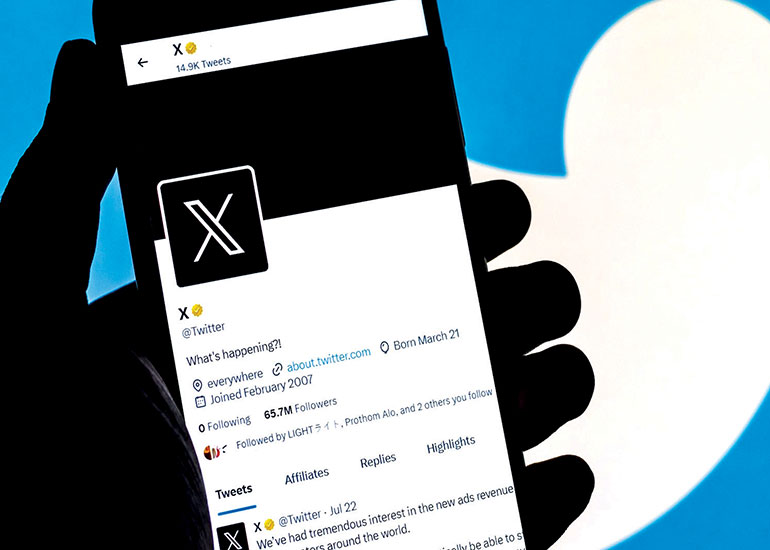A billboard can be many things: a dream-seller, an eye-grabber, a witty one-liner, or, unfortunately, a bad concoction of art and ad. However, a recent tragedy in Mumbai saw a billboard take on a destructive role, resulting in 17 deaths and injuring many more. Though rare, this catastrophe prompts a critical examination of illegal OOH (Out-of-Home) installations and the regulations governing the industry. Industry experts share their insights with IMPACT on the existing rules and how it can collectively prepare for unforeseen mishaps.
According to the Pitch Madison Report 2024, the OOH industry surpassed the Rs. 4000cr. mark in ad spends in 2023, up from Rs. 2178cr. in 2021. This rapid growth is, however, marred by instances of illegal billboards constructed across states, often exceeding size limits or ignoring other regulations. While most players comply with rules, some remain irresponsible. When such negligence combines with an ‘Act of God’ situation like a thunderstorm, it can lead to disaster.
On May 13, Mumbai was hit by a thunderstorm, causing the uprooting of an illegal 14,400-sq ft. billboard in the Ghatkopar area. This led to 17 deaths and over 70 injuries. The owner of the illegal installation, with a history of complaints, has been arrested. Moreover, the Indian Outdoor Advertising Association (IOAA) has extended support to the government and BMC initiatives to audit hoarding structures. Yet, questions remain about the rules in place and what more can be done. Rajneesh Bahl, CEO, Zest Outdoor, a major OOH player in Mumbai, notes, “Despite regular thunderstorms, incidents like these are not common in a city that houses 40% of the country’s billboards. The hoarding that fell wasn’t constructed properly, and its foundation was inadequate, leading to the tragedy. Therefore, it would not be ideal to blame the whole industry for one person’s ignorance.”
Rajneesh Bahl, CEO, Zest Outdoor, a major OOH player in Mumbai, notes, “Despite regular thunderstorms, incidents like these are not common in a city that houses 40% of the country’s billboards. The hoarding that fell wasn’t constructed properly, and its foundation was inadequate, leading to the tragedy. Therefore, it would not be ideal to blame the whole industry for one person’s ignorance.”
Discussing the existing framework, he adds, “Outdoor installations in Mumbai are constructed on lands owned by the BMC, the Railways, and occasionally on Government Railway Police (GRP), where the incident occurred. Our hoardings on railway lines adhere to stringent policies and are audited by reputed institutions like IIT Bombay, to ensure safety.”

 Similarly, Yogesh Lakhani, Founder and Head, Bright Outdoor Media acknowledges the checks and regulations maintained by the Railways. He explains the requirements for BMC land, stating, “The Railways have systematic frameworks with proper checks and balances. For projects on BMC land, a certificate from a BMC-approved architect is required to begin the process. Additionally, the size of the billboard cannot be increased without consulting the architect.”
Similarly, Yogesh Lakhani, Founder and Head, Bright Outdoor Media acknowledges the checks and regulations maintained by the Railways. He explains the requirements for BMC land, stating, “The Railways have systematic frameworks with proper checks and balances. For projects on BMC land, a certificate from a BMC-approved architect is required to begin the process. Additionally, the size of the billboard cannot be increased without consulting the architect.” Speaking on the existence of illegal sites, Dipannkar Sanyal, CEO, Platinum and MRP says, “Illegal sites do not exist because of lack of regulation but due to the lack of willingness to implement the existing regulations. If we speak about Mumbai specifically, then numerous legal sites have also come up. Mumbai has led the march towards digitisation of large format billboards. So it’s not the lack of regulations that has impacted business.” There is no congruence between the rules in different states of India. While the BMC is planning to tighten the regulations post-incident, Bengaluru’s Mahanagara Palike (BBMP) took a different approach a few months ago by relaxing its previously strict rules. In 2018, BBMP had banned all forms of commercial advertising in the city, except those under public-private partnerships. However, this ban has now been reversed, allowing for more flexible advertising policies in the city.
Speaking on the existence of illegal sites, Dipannkar Sanyal, CEO, Platinum and MRP says, “Illegal sites do not exist because of lack of regulation but due to the lack of willingness to implement the existing regulations. If we speak about Mumbai specifically, then numerous legal sites have also come up. Mumbai has led the march towards digitisation of large format billboards. So it’s not the lack of regulations that has impacted business.” There is no congruence between the rules in different states of India. While the BMC is planning to tighten the regulations post-incident, Bengaluru’s Mahanagara Palike (BBMP) took a different approach a few months ago by relaxing its previously strict rules. In 2018, BBMP had banned all forms of commercial advertising in the city, except those under public-private partnerships. However, this ban has now been reversed, allowing for more flexible advertising policies in the city.
 Imtiyaz Vilatra, Managing Director, Posterscope, a major player from the Dentsu group, remarks “As a leading player in the OOH advertising space, Posterscope recognises the significant impact of regulatory changes on the industry. The 2018 bylaw in Bengaluru led to a substantial decline in OOH budgets, by an estimated 50-60%. However, the industry demonstrated resilience and adaptability amidst these challenges.”
Imtiyaz Vilatra, Managing Director, Posterscope, a major player from the Dentsu group, remarks “As a leading player in the OOH advertising space, Posterscope recognises the significant impact of regulatory changes on the industry. The 2018 bylaw in Bengaluru led to a substantial decline in OOH budgets, by an estimated 50-60%. However, the industry demonstrated resilience and adaptability amidst these challenges.”
The rules vary from state to state, with various bodies overseeing different aspects. Parameters like billboard size and location are scrutinised by relevant corporations and government bodies, and there is wide acceptance of these rules from the industry. Nonetheless, industry professionals like Rajneesh Bahl advocate for a uniform set of rules for better clarity and safety. Parle uses OOH efficiently, and around 5% of their ad spends go into this medium. Taking the conversation ahead, Krishnarao Buddha, Senior Category Head, Parle Products comments, “The biggest problem in the OOH space is the lack of corporatisation and significant fragmentation. While the industry is improving and becoming more organised, a large portion remains unorganised. Additionally, varying guidelines across states are another key concern.”
Parle uses OOH efficiently, and around 5% of their ad spends go into this medium. Taking the conversation ahead, Krishnarao Buddha, Senior Category Head, Parle Products comments, “The biggest problem in the OOH space is the lack of corporatisation and significant fragmentation. While the industry is improving and becoming more organised, a large portion remains unorganised. Additionally, varying guidelines across states are another key concern.”
The Mumbai incident is a moment of revelation for the OOH industry. However, the larger commitment shown by professionals should not be undermined. While there is a need for tighter safety measures and standardised regulation, the industry remains resilient and continues to grow. By learning from this incident and making necessary improvements, we can ensure that outdoor advertising remains a dynamic and safe part of the advertising landscape.
























